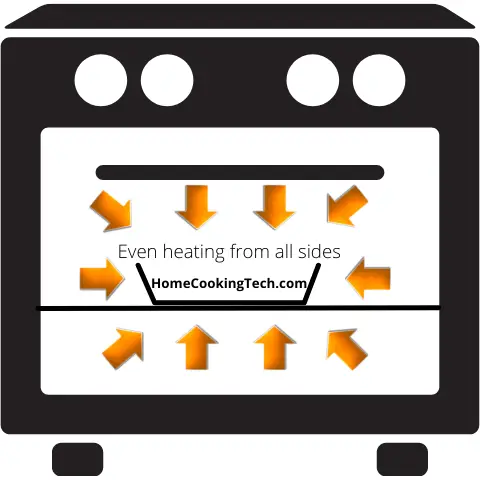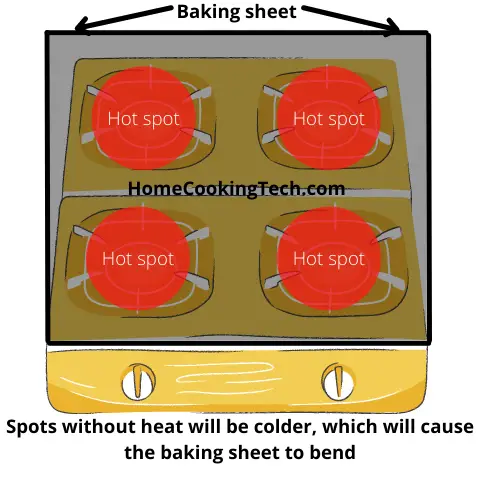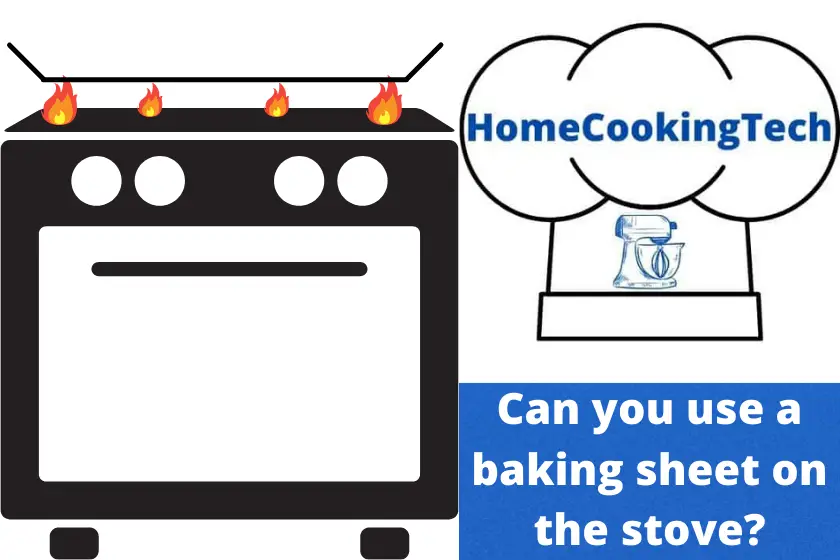Baking sheets are often used in the oven, but can they be used on the stovetop? With a bit of care, the answer is “yes”! A baking sheet with good heat conductivity and one that is big enough will work well on the stovetop.
What should you watch for? Which baking sheet material is good to be used on a stovetop? Let’s take a look, shall we?
What to look for when using a baking sheet on the stove
Maybe you don’t have an oven. Perhaps you have some special recipe, maybe you are making a sauce, or want to try something new.
The important thing here is to make sure that you are using a big enough baking sheet.
The reason for it is that you need to cover your stovetop completely. Because if you are, for example, using a gas stove and it is too small, the flame could quickly start ‘leaking‘ from sides and burn you.
This is not an issue with an electricity-powered stove but is still something you should keep in mind. The reason is that even if your stove is electric, but the baking sheet is smaller than heaters, it could lead to uneven heating of a baking sheet.
Differences in baking sheet materials
This is the second most crucial thing to think about when planning to use a baking sheet on a stove.
Baking sheet materials have different heat conductivity and act differently when you heat them from the bottom.
Some will heat up fast, some slow, some will warp or bend, and some don’t, and some may even be dangerous as they were not designed to be used this way.
For example, using a baking sheet that has a non-stick layer can easily crack and release fumes that would make you sick if you inhale them for some time.
In general, you can say that materials, from my detailed article, that conduct heat very well are not so good to be used over direct heat; if they are in the form of a baking sheet.
Here are materials like aluminum, copper, or non-stick coating.
On the other hand, the materials that work pretty well are cast iron, stainless steel, and titanium.
Most of us do not have the money to own a titanium baking sheet. Still, if you plan on using a baking sheet on a stove more often, I would make sure that it is made out of durable material.
Great choice in this is a stainless steel baking sheet, like the one part of this set from Amazon.
Another option would be to use your old baking sheets that you don’t care about that much anymore. They will get burned and will most likely warp if made out of material with good heat conductivity.
If you choose to go this way, make sure that it is either made from a singular material or that it has been scratched down to it from both sides.
I am saying this because if you have a non-stick layer over your baking sheet and it has been damaged in some way, it can easily leak fumes that can poison you.
If the baking sheet is ‘barebone,’ the risk is much lower.
Baking sheet warping
I have used the word ‘warp‘ a couple of times now in this article. What is meant by it is that when you put the baking sheet on a stove, it won’t be heated evenly from all sides and places, as you most likely have four heaters of various sizes.
Four corner spots of a baking sheet will be heated to high temperatures. At the same time, the rest will partially benefit from the heat but will not be heated to an equal temperature. Therefore it will cause the baking sheet to bend in different spots.
The better conducting material, the higher chance this will happen. So this part is similar to the previous one.
Let me clarify that with pictures.


Again, I recommend using either a baking sheet you don’t plan to use anymore or one made out of tougher materials like stainless steel.
I will guess that you don’t want to use a wobbly baking sheet in the long term for some serious cooking. So I would recommend using the baking sheet in this way for one specific thing, like sauce making.
With these two most essential caveats out of the way, let’s discuss some tricky questions related to using the baking sheet on the stove.
Can you cook on a baking sheet?
Sure, you can use your baking sheet as a temporary pan.
In this case, I would recommend using a smaller baking sheet, as you would need only one heater, and it should behave as a regular pan.
As this sounds like a more long-term thing, get the baking sheet that will last for some time. My recommendation is this cast iron set from Amazon. If you do get one buy it without coating. Color only makes it likable, but it will get in a way as you use it over direct heat.
If you treat your cast iron properly from time to time, it will serve you whole life. This is a fantastic option if you need reliable cookware. It will allow you to cook on any surface that you wish.
Can you fry on a baking sheet?
Similarly to cooking on a baking sheet, I would say yes, you can fry on a baking sheet if you are doing it occasionally.
In a case that you plan to fry more often, I would recommend getting a deep fryer or at least a pot to fry in.
Can you bake on a stovetop?
I have to say a resolute NO to baking on a stovetop. Baking works because it provides an equal amount of heat from all sides.
On a stovetop, you cannot ensure that there is enough heat provided to all parts of your dish at all times.
This is even more true if you would like to bake on a stovetop on a baking sheet. The result would be an unevenly baked mess with parts cooked through and parts runny. In theory, you could resolve this by spinning and repositioning the baking sheet every few minutes, but trust me; it would create more issues than it resolves.
Is it safe to use a baking sheet on the stove?
It is if you are present and monitoring what is happening.
The most significant difference between the oven and stovetop is that the stove provides a constant influx of heat, and the oven keeps the preset temperature.
If you don’t monitor the stovetop, you can quickly burn anything on your baking sheet.
In all cases, it is good to protect yourself while using a baking sheet, so get yourself heat-resistant cook mittens.
I adore the ones covered in silicone, as they protect my hands from extreme heat. Check out these silicone babies on Amazon.
And that is it.
I hope that I have answered your question about using a baking sheet on a stove.
Did I miss anything in the article? What is your experience of using baking sheets on a stovetop? Do let me know in the comments below.
Until next time I wish you happy and warp-free cooking.




















